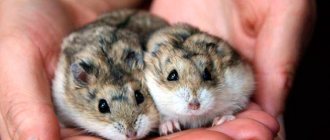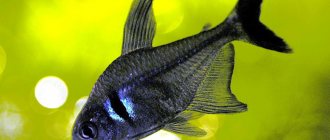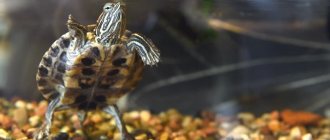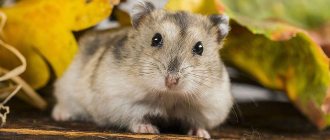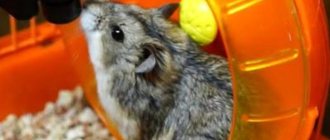To keep red-eared turtles at home, you need a properly equipped aquarium of adequate size. It would be more accurate to call it an aquaterrarium, since such a reservoir contains not only a body of water, but also an island of land. You can buy housing for turtles in special. stores or do it yourself.
Since the reptile is quite demanding about its place of residence, you need to know how to properly set up an aquarium for a red-eared slider. Your pet's home should be as close as possible to its natural habitat. Only in this case will your ward be healthy and happy in his own way.
Aquarium volume for a red-eared turtle
You need to approach the choice of an aquarium based on the size of your red-eared pet or (if you have a young individual) take it right away “for growth.” Keep in mind. that in a few years a tiny turtle the size of a peach pit will turn into an adult the size of a saucer.
The optimal size of the aquarium depending on the size of the turtle:
- babies from 3 to 10 cm – 50 liters;
- young turtles from 10 to 16 cm - 80 liters;
- large turtles from 17 to 25 cm – 150 liters;
- adult animals – from 150 liters.
In order to prevent the red ear from escaping, the top of the aquaterrarium should be closed with a lid that allows air to pass through well.
Making a removable partition
The design can be equipped with a removable partition. To do this, it is permissible to use two strips of glass, which should be glued to the bottom using sealant, the step between them should be equal to the width of the glass. The height should be made equal to four centimeters. Between them you should install thick glass, which needs to be sealed with a background. The partition is sometimes made using waterproof plywood; in this case, the elements need to be shaped like the letter “T”. You can use plastic glass runners when making partitions, but in this case they should be installed on the sides and not from the bottom. After you succeed in making an aquaterrarium for a turtle with your own hands, you can let the animal inside.
Temperature
The recommended water temperature for the red-eared turtle is 23-28 °C. The temperature on a shaded (cold) island of land should be 23-25°C, and on a brightly lit (warm) area - 28-32°C. This is an absolutely ideal option for arranging the most suitable temperature conditions for the red-eared turtle.
To create such temperature conditions, heating is necessary. The main heating is carried out using a special lamp, which is fixed above one of the islands. If the temperature when heating with a lamp is insufficient, then additional heating is used.
You can use a heater in the form of a long glass tube that is immersed in water. Particular attention should be paid to its location: the turtle should not be able to accidentally bite the electrical wire or damage it with its shell.
Conditions and equipment
When setting up an aquarium, you should first place all the necessary equipment in the tank and make sure that the conditions created are acceptable for keeping turtles. In aquaterrariums the following is installed:
- heater;
- filter;
- lighting;
- Ultraviolet lamp.
The heater is installed to maintain the required temperature: in dark areas 23–26C, in illuminated areas – 28–30C. The main heating is created by a special lamp located above the land islands, but if this is not enough, then another device is additionally installed.
External filters are used for aquariums, as internal ones quickly become clogged. Water changes are carried out weekly, replacing 40–50% of the liquid with settled water.
A UV lamp is one of the most important devices for the life of turtles. Ultraviolet radiation helps animals synthesize vitamin D3 and absorb calcium, and without it, pets will simply die. Ultraviolet daylight should last 12 hours, and only UVB and UVA rays are suitable.
Filtration
The health of the turtle directly depends on the state of the water in the aquarium, so it must be kept clean. For a terrarium, it is better to use external aquarium filters of any type.
It is not advisable to install internal equipment, as it quickly becomes clogged with suspensions, losing efficiency.
The better the filter works, the less often a complete water change will be needed.
To maintain ecological balance, regular weekly replacement of half the volume of water is necessary. Before replacing, the water is allowed to settle.
Incandescent lamp
An ordinary incandescent lamp (an energy-saving lamp will not work) is installed above the island at such a distance that the air temperature above this area of land is 30-32 ° C. At night it is turned off.
UV lamp
Some owners of red-eared turtles neglect to install a UV lamp. However, this is a vital component of a reptile’s home. Its absence often leads to the development of diseases that can be fatal. Ultraviolet light is extremely important for the health of the red ear. It has a beneficial effect on metabolism, improves the condition of the reptile’s shell and skin, and helps the absorption of calcium. The UV lamp is placed at a height of at least 30 cm above the shore. It should burn for at least 2-3 hours a day.
Today you can purchase special lamps for terrariums with the required wavelength in almost any specialized store.
Ultraviolet lighting
The main principle of keeping turtles in captivity is to create a natural environment. In nature, turtles love to bask in the sun, so in an artificial pond you will need:
- An incandescent light bulb is placed over land to achieve a temperature of 23-28C. At night the lights are turned off.
- The most significant aspect in keeping red-eared turtles is considered to be ultraviolet lighting, with the help of which the reptiles absorb calcium, which is necessary for the strength of the shell. In terrariums, UV lamps must be installed at a distance of at least 30 cm from the soil. Daylight hours are 12 hours.
Aquarium decoration
The main principle of choosing decorations is safety. Do not use items made from environmentally hazardous materials or with sharp corners or edges.
The soil for the bottom should not be very fine, as turtles can sometimes swallow it. Also, fine soil quickly becomes contaminated and is difficult to clean. It is better to use pebbles with a fraction of 5-6 cm.
For young turtles, you can plant green plants and introduce fish. Adults do not need soil, and they can eat or damage plants and fish.
In an aquarium with red-eared turtles, artificial plants made of plastic or silk would be appropriate. They are secured in the ground using weights. You can also install artificial vines on the islands.
To decorate the terrarium, you can use a variety of driftwood, grottoes, unusual stones and other elements. The driftwood should not be fresh, as it will release harmful substances into the water. It is better to take pieces of wood that have lain in the water of a body of water for a long time. The bark needs to be removed from them.
FILLING THE AQUATERRARIUM
The larger the area of the turtle's home, the more opportunities for creating beautiful decor.
Stones are usually placed at the bottom of the aquarium; you can buy colored stones for aquariums - but be sure to choose all of them that are smaller in size than your pet’s head, so that he does not swallow them and choke. Sturdy shells without sharp edges also look great. Turtles love to dig and dig , turn over and drag everything that gets into their aquarium. Even plastic algae, usually sold with a base, can be easily peeled off. Therefore, it will not be possible to arrange a beautiful, neat landscape - the turtle will quickly arrange everything the way it likes.
In this regard, it is better to place on the bottom either something that can be easily moved and that changing places will not affect the overall appearance - for example, stones, shells and pieces of glass, or large objects that cannot be moved. These can be special driftwood, inside of which, by the way, you can hide a heater, or ceramic elements. You should not buy hollow snags and caves; the turtle can climb into them while it is small, however, it is just as likely to get stuck there.
You can glue photo wallpaper to the back of the aquarium. It is useless to plant algae near turtles; very soon they will be torn out and most likely eaten. However, in general, placing them in the aquarium is a good idea, but they are specifically edible and tasty for the turtle to enjoy. Those that float on the surface are most suitable.
Video: content
Temperature
Turtles are cold-blooded animals. This means that their activity directly depends on the environment - when the temperature drops, the turtle will begin to move little and sleep a lot, and may even hibernate, which is extremely dangerous for domestic turtles. Cold water is also dangerous because your pet may develop pneumonia, in other words, he will catch a cold.
The optimal temperature is about 25-28 degrees . To maintain it in winter, it is enough to purchase a good heater for aquariums - it will automatically turn on when the temperature drops and heat the water to the specified level. This is especially true in winter.
Note!
There are aquariums in which red-eared sliders cannot be kept:
- Small turtle tanks with a volume of up to 50-70 liters. They can only be used for temporary housing of animals. If a turtle lives in such a container for a long time, then it develops skin infectious diseases, dystrophy and softening of the shell.
- Aquariums in which the land is made of plastic.
- Aquariums in which it is impossible to set the desired temperature, as well as ultraviolet light and filtration. The absence of all these conditions leads to illness and death of turtles.
Thus, caring for a red-eared slider, like any other pet, requires some effort. But a terrarium in which the water is clean, the bottom is picturesque, and the animals are healthy is a fascinating sight that is worth the time and effort.
The presenters of the Karusel TV channel will tell you how to properly equip a terrarium for a red-eared turtle:
Priming
For the red-eared birds themselves, the soil in their home is not particularly important or necessary. Another thing is that owners usually try to decorate their pet’s habitat. Of course, the aquaterrarium should look aesthetically pleasing. But do not forget that not all materials are suitable for this purpose.
Large stones without sharp edges or pebbles at least 5 cm in size are suitable as soil. The reptile can swallow small pebbles, which will lead to serious health problems, and the sharp edges can injure the reptile.
In principle, it is not forbidden to use sand as soil. The only “but” is that cleaning an aquaterrarium with sand is not very convenient.
Large shells will not only decorate your pet’s home, but will also saturate the water with calcium.
It is prohibited to use various plastic and glass pebbles for aquariums.
Plants in an aquaterrarium
There is no point in planting plants in the red-eared home. Without thinking twice, your pet will eat them or dig them up. You can try decorating the aquarium with commercially available artificial plants, securely fastening them to the bottom. You can do without plants altogether by decorating the aquarium with various driftwood, unusual stones, etc. But keep in mind: you should only take driftwood that has been in the water for a long time. Fresh wood is not suitable.
An interestingly designed aquarium for red-eared turtles will add zest to any interior. But do not forget that when choosing decorations, first of all you need to think about the safety of your pet.
Stages of work
Cut pieces of glass must be pre-treated - rub the sharp edges with sandpaper. The cuts should be as even as possible, a discrepancy of no more than 1-1.5 mm is allowed, otherwise it will be difficult to achieve tightness of the joints. When sanding, sharp particles of glass dust can get into your lungs, so you need to wear a protective mask when sanding the edges. At home, it is better to use the bathroom for work; a constantly running shower helps to quickly wash away dust. After preparing the parts, perform the following steps step by step:
- A strip of tape is glued to one of the sides so that it extends beyond the edge.
- The second part is carefully lowered onto the sticky side of the tape, then both parts are lifted and folded at an angle, with the tape inward.
- Using tape, all four sides of the aquarium are assembled and placed vertically - you need to check that the glass fits as tightly as possible to each other and that the sides are parallel.
- All joints are degreased with alcohol and coated with glue-sealant in two layers - each layer is leveled using a piece of paper; To prevent the glue from staining the glass, it is recommended to glue additional vertical strips of masking tape, which are removed after completing the work.
- Glue cannot be saved, it must fill the joints completely - for a better result it is better to use a special gun that squeezes out the glue in even portions; If the adhesive layer is not dense enough, a joint leak may form under water pressure in the future.
- A part of the bottom of the aquarium is laid on top of the structure, first on small droplets of silicone, then when the evenness of the joints is checked, they are also degreased and coated with silicone.
- The aquaterrarium is left to dry for several hours, then carefully turned over.
- All tape is removed, traces are washed if necessary, and internal joints are degreased.
- All seams are coated with glue in two layers, then they are also allowed to dry.
- The aquarium is left to dry for at least a day, after which water is filled and left for several days to check for leaks. Corners usually leak - if a leak is detected, the water is drained, the joints are dried with a hairdryer and coated with another layer of sealant.
After drying, excess silicone is carefully cut off using a stationery knife. A large aquarium can be reinforced with stiffening ribs - to do this, you need to place horizontal strips of glass or plastic 4 cm wide on the wide walls in the corners. 3 cm are removed from the top of the side; fastening is done using glue. In the future, these strips can be used as a support for a protective mesh or cover.
How to equip an island?
The red-eared turtle leads a sedentary lifestyle, spending a lot of time not only in the water, but also on the shore, so the aquarium must be equipped with at least one, or preferably several, land areas per turtle (one in a shaded place, and the other in a brightly lit, warm place ). On land, the turtle receives oxygen and enjoys UV rays.
What is important to consider?
- The land area should occupy at least a quarter of the entire bottom area.
- Land areas should have a sloping shore that smoothly rises from the bottom. Steep cliffs are not allowed. You can build a ladder or a mini-ladder, put a large stone or a grotto with gentle walls.
- The surface of the islands must be made of high-quality materials and be rough. If there is soil on the island, it should not crumble into the water.
- If there are several turtles, then the land must have such a total area that all individuals simultaneously have access to it and can fit.
- If there are several islands, then some of them may not be completely dry, but covered with water by several millimeters.
The island should be located approximately 30 cm below the edge of the terrarium so that the animal does not get out and run away.
Reptile Neighborhood
The red-eared turtle lives on land and loves to live in the water. She is very demanding of her environment. Therefore, choose aquariums that match the size of the animal, as well as those with access from the water to land.
Do not move new household members into terrariums with seasoned reptiles. The animal experiences stress from a change in environment and therefore becomes aggressive. Create a quarantine for 2 months. Newborn turtles should be treated with care and should have a separate place to live. Pets of the same size live next to each other without harming each other.
The proximity of red-eared turtles to aquarium fish in the same aquarium is not allowed. Reptiles can harm or eat fish. The maximum that can be done is to block a glass wall with small holes between them.
Prohibited aquariums for turtles
The following aquariums should not be used for aquatic turtles:
Are you concerned about the health of your pet? We are responsible for those we have tamed!” - says a quote from the story “The Little Prince”. Maintaining the health of a pet is one of the main responsibilities of the owner. Take care of your pet by giving him the Vitatame . The unique complex is designed for cats and dogs, as well as birds and rodents. Vitatame active supplement will help your pet shine with health and share happiness with you!
- Having a volume of 50−70 liters. If a turtle lives in such a small space for a long time, then over time it develops infectious skin diseases, degeneration and softening of the shell.
- In which the sushi island is made of plastic.
- In which it is impossible to install lighting, ultraviolet lamps and filtration. Their absence leads to the death of turtles.
Thus, caring for a red-eared turtle is still not very easy. Only compliance with all conditions of proper maintenance makes the life of turtles long and happy.
Fixing the door
An aquaterrarium for aquatic turtles, like any other, must have a door; it can be secured using a certain technology. In order to ensure that the door moves to the side, you can use runners borrowed from a bookshelf. Most often, when using this technique, two glasses are used.
Initially, you need to prepare two strips of glass, the width of one should be 1/3 of the total height of the terrarium, while the width of the other should be equivalent to 15 cm. You need to choose glass for the door in such a way that its thickness is equal to 4 millimeters. The length of the strips should be equal to the front panel of the terrarium. The first strip needs to be glued to the bottom, while the second is fixed to the top. Glass holders can be installed in such a way that the glass can be pulled out towards you. The door can be installed with magnets, but this approach is considered not very reliable, since in this case the animal can open it independently.
Climate maintained in the terrarium
afraid of drafts and hypothermia
Lighting fixtures should be placed in the room in such a way that the turtle can choose what it prefers to do at the moment. Warm yourself under a lamp or retire to a cool corner of the room. Where the heating lamp is installed, the air temperature should be around thirty degrees. In the opposite corner, the air temperature should not fall below twenty-three degrees. It is not recommended to heat the bottom of the terrarium with special means in the form of mats, as this may have a negative effect on the functioning of the animal’s kidneys. Therefore, if the room temperature drops below the specified heating lamp, you need to change it to a more powerful one.
The feeder is placed only while the turtle is feeding. Leftover food is removed immediately after the meal. The place that is best suited for these purposes is a warm corner under a lamp. A drinking bowl with clean water should always be in the same place.
The ultraviolet lamp in the pet's room should be turned on daily for at least ten hours. But it is better to extend the procedure to twelve hours. For other inhabitants of the apartment, including people, this lamp is harmless, so there is no need to be afraid of its effects. If in the summer it is possible to walk the turtle in the sun, then during this period the ultraviolet lamp does not need to be turned on. The turtle will get everything it needs from the sun.
A bathhouse for tropical species should be such that the water in it can be easily changed daily. And the sides are low so that the animal can climb in and out without outside help. This container is installed in a warm corner of the room.
The turtle sleeping house is installed in the cold part of the terrarium. It is mandatory for the animal, so if you don’t want to purchase a special design in pet stores, you can install a simple cardboard box in which the pet will hide.
The turtle is a symbol of wisdom, peacefulness and friendliness. Such a companion can provide her owners with many years of friendship and mutual understanding if her owners provide her with normal living conditions.
What helps maintain humidity in a terrarium?
Keeping many exotic pets requires a certain level of humidity in the terrarium. For some animals, high humidity is indicated, for others, humidity is contraindicated. For example, hamsters will feel great in dry sawdust, Achatina snails vitally need a wet extract, mantises will not be able to survive if there are drops of condensation in the terrarium.
The required soil moisture for pets is different:
- Humidity for Achatina snails is checked in this way - squeeze a handful of soil in your hand, if water drips, then the soil is waterlogged. Achatina snails react negatively to high humidity: they hibernate, become lethargic, and lose their appetite.
- Moisture is also important for ants. You can determine the level of sufficient moisture in the formicarium as follows: if perspiration appears on the walls, stop spraying.
- The soil in the praying mantis terrarium should be sprayed rarely. It should be slightly damp. How often this needs to be done is difficult to say for sure, it depends on the air circulation in the terrarium.
- The optimal humidity level for the tarantula spider is 35-60%.
A hygrometer determines the humidity level in the terrarium




